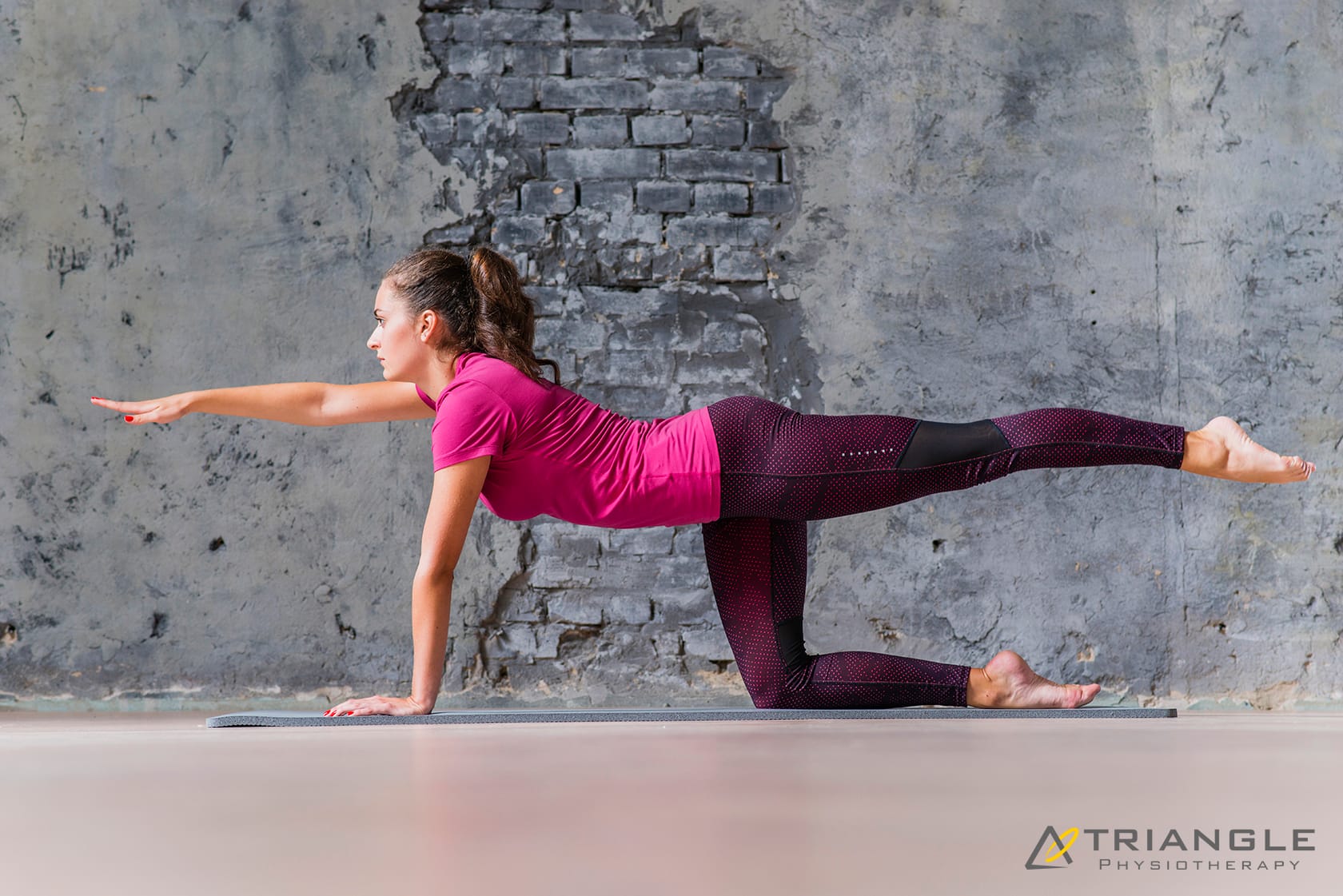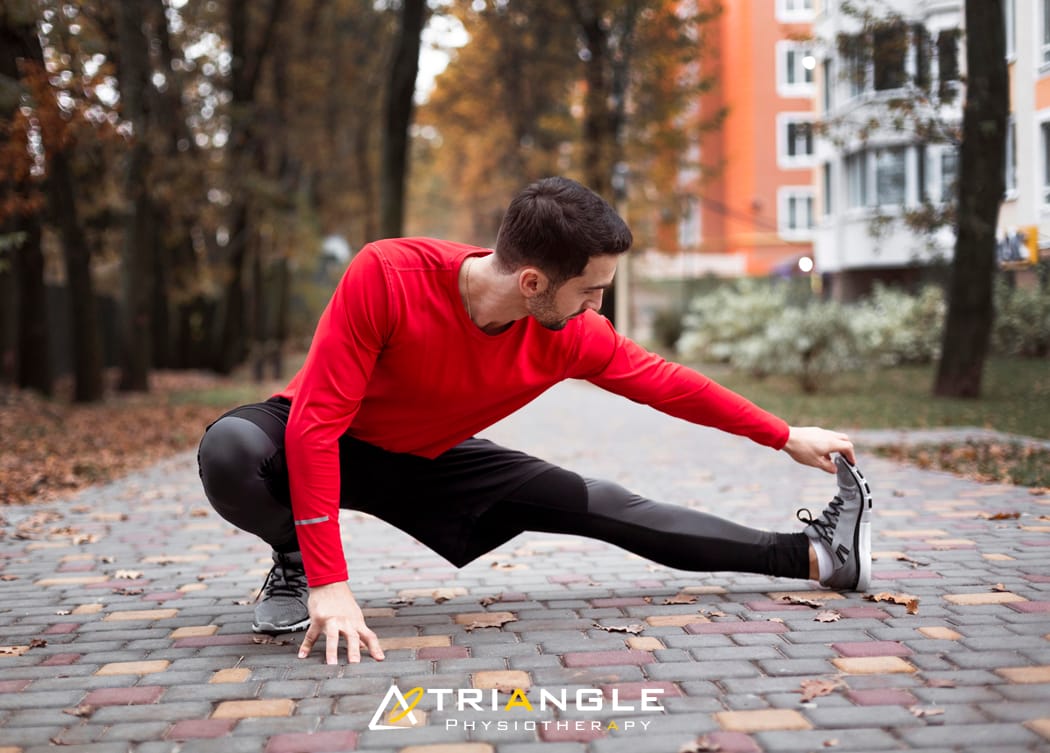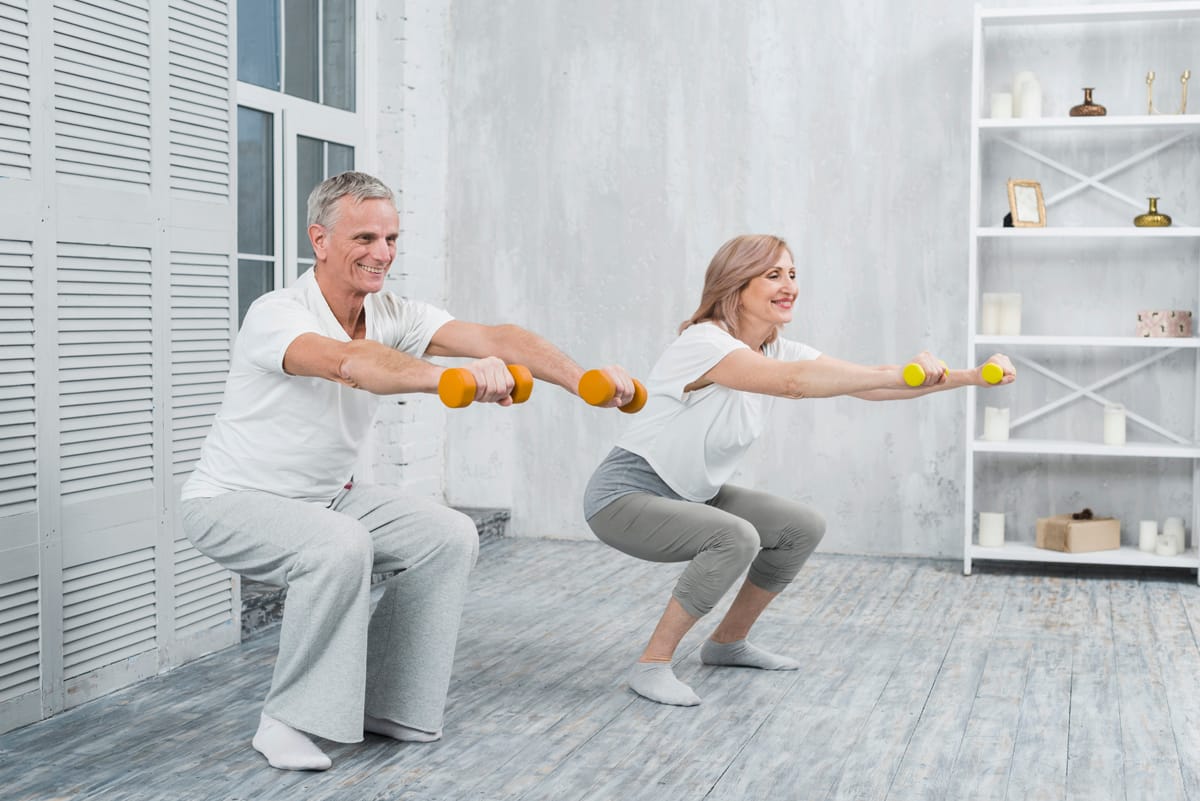Living an active lifestyle is crucial for our overall health and well-being. It’s not just about hitting the gym; it’s about integrating movement into your daily life. Whether you’re looking to enhance your mobility or recover from an injury, physiotherapy in Oakville can play a key role in helping you stay active. Here are seven tips that can help you embrace a more active lifestyle, focusing on various exercise types, prevention strategies, and the importance of physiotherapy.
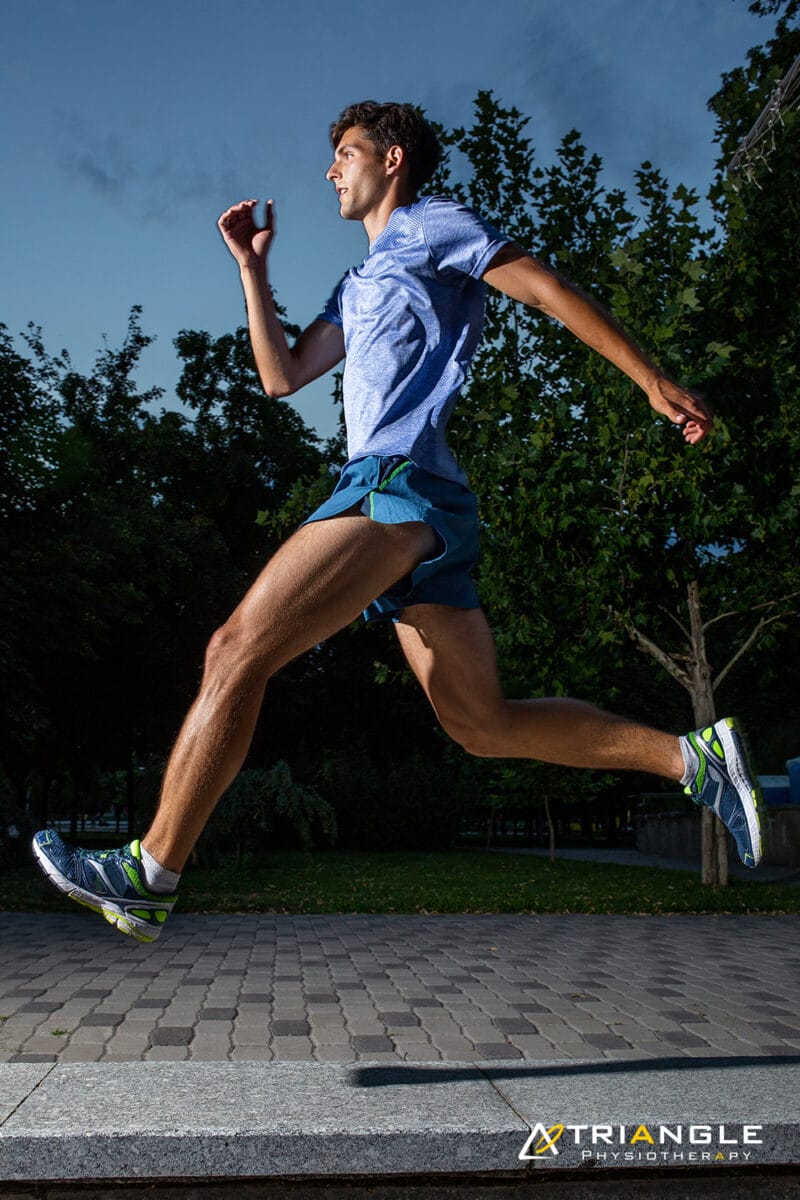
1. Embrace Neuromuscular Exercises
Neuromuscular exercises are all about improving your body’s ability to perform coordinated movements. Think of activities like yoga, Pilates, or tai chi. These exercises enhance balance, agility, and coordination, which are essential for daily activities and overall mobility.
Start by incorporating short sessions into your routine. Even 15 minutes of yoga in the morning can make a difference. If you’re in Oakville, you can consult a physiotherapist to ensure your movements are precise and safe, helping you avoid injury. As you become more comfortable, explore different styles or join a class to keep things exciting.
2. Incorporate Progressive Resistance Exercises
Progressive resistance exercises are crucial for building strength and endurance. These exercises involve gradually increasing the amount of weight or resistance you use, helping your muscles adapt and grow stronger over time.
You don’t need a gym membership to do this. Bodyweight exercises like push-ups, squats, and lunges can be done anywhere. For those in Oakville looking to enhance their routine, physiotherapy can offer personalized advice on proper technique, especially if you’re recovering from an injury or have muscle imbalances. Aim for two to three sessions per week, focusing on major muscle groups for balanced strength development.
3. Prioritize Mobility Exercises
Mobility exercises enhance your range of motion and flexibility, reducing the risk of injury. Think dynamic stretches or mobility drills that prepare your body for movement.
Integrate these exercises into your warm-up routine before any physical activity. Simple movements like arm circles, hip openers, and ankle rolls can improve your mobility significantly. If you’re looking for guidance, physiotherapy in Oakville can assist in identifying areas of stiffness or restricted movement and provide tailored exercises to improve your flexibility.
Good mobility isn’t just for athletes; it’s essential for everyone. It helps with daily tasks like bending down to tie your shoes or reaching for items on high shelves.
4. Focus on Prevention
Incorporating preventative measures into your active lifestyle is key. This includes listening to your body and recognizing signs of overexertion or fatigue. Stretching before and after exercise can help reduce muscle tension and soreness.
If you are in Oakville, regular visits to a physiotherapist can help you prevent injuries before they happen. They can evaluate your movement patterns and suggest exercises that align with your fitness goals while minimizing the risk of injury. Prevention is always better than cure, so pay attention to your body’s signals and adapt your routine accordingly.
5. Understand the Importance of Physiotherapy
Physiotherapy plays a vital role in maintaining an active lifestyle, especially if you’ve had past injuries or chronic pain. A physiotherapist can assess your movement patterns, identify weaknesses, and design a tailored exercise program to help you improve.
If you’re in Oakville, a local physiotherapy clinic can provide valuable insights even when you feel fine. Consulting a professional early on can help you develop a balanced routine that enhances your strength and mobility, reducing your risk of injury in the long run.
6. Tips for Safely Performing Exercises
Safety should always be a priority when exercising. Here are some tips to ensure you stay injury-free:
- Warm Up and Cool Down: Spend at least five to ten minutes warming up before any workout and cooling down afterward.
- Focus on Form: Proper form is essential to prevent injuries. If you’re unsure, don’t hesitate to ask for guidance or watch instructional videos. Better yet, seek advice from a physiotherapist in Oakville to ensure you’re doing exercises correctly.
- Start Slow: If you’re new to a type of exercise, ease into it. Gradually increase intensity and duration as your body adapts.
- Stay Hydrated: Dehydration can lead to fatigue and injuries, so drink plenty of water before, during, and after exercise.
7. Make Movement a Daily Habit
Lastly, find ways to incorporate more movement into your daily routine. Take the stairs instead of the elevator, walk or bike for short errands, or even set a timer to remind you to stretch or take a quick walk every hour.
If you’re based in Oakville, there are various local parks and trails where you can get moving outdoors. Additionally, a physiotherapy consultation can help you find creative ways to integrate movement into your routine, especially if you’re dealing with mobility limitations.
The key is to make movement enjoyable. Try different activities until you find what you love, and remember that every little bit counts!
Check out this article on the Concept of Wellness.

Glute exercises are fantastic for improving overall lower body strength, stability, and athletic performance. The gluteal muscles exert significant effort in maintaining alignment, contributing to both posture and movement, enhancing strength, and providing support to adjacent muscle groups as well.
Why are strong Glutes important?
Strong glutes are essential for various reasons:
- Improved Posture: Strong glutes help maintain proper alignment of the pelvis, which is crucial for good posture. Weak glutes can contribute to postural imbalances and increase the risk of lower back pain and injury.
- Enhanced Athletic Performance: The glutes are powerhouse muscles involved in many movements, including running, jumping, and lifting. Strengthening them can improve performance in sports and other physical activities.
- Prevention of Injuries: Strong glutes can help stabilize the pelvis and knees, reducing the risk of injuries such as ACL tears, IT band syndrome, and lower back pain. They also provide support during movements that involve rotation or lateral movements.
- Increased Strength: The glutes are one of the largest muscle groups in the body. Strengthening them can improve overall lower body strength, making daily tasks easier and enhancing functional fitness.
- Better Aesthetic Appearance: Developed glute muscles contribute to a toned and sculpted lower body appearance. Many people aim to strengthen their glutes for aesthetic reasons as well as functional benefits.
What muscles make up the Glutes?
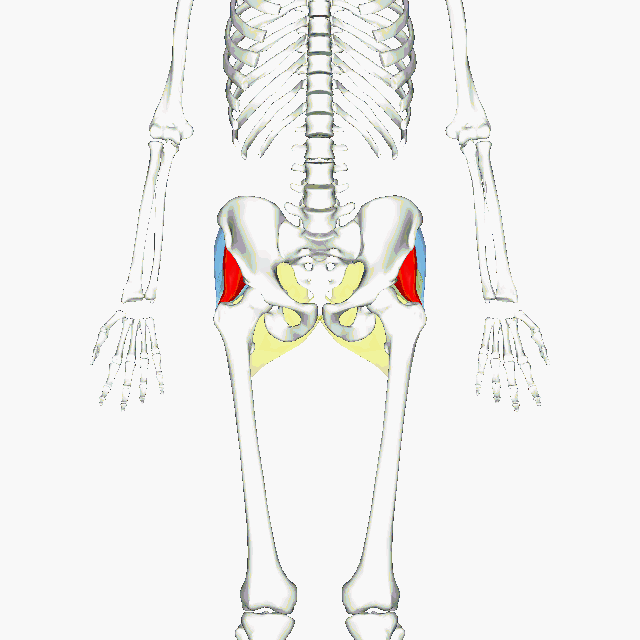
Gluteal Muscles. The Maximus (yellow), medius (blue) and minimus (red).
The glutes, or gluteal muscles, are comprised of three main muscles:
- Gluteus Maximus: This is the largest muscle in the gluteal group and one of the strongest muscles in the human body. It forms much of the shape and appearance of the buttocks. The gluteus maximus is primarily responsible for hip extension, such as when you stand up from a seated position or climb stairs.
- Gluteus Medius: Located on the outer surface of the pelvis, the gluteus medius is responsible for hip abduction (moving the leg away from the body’s midline) and internal rotation of the hip joint. It plays a crucial role in stabilizing the pelvis during activities like walking, running, and standing on one leg.
- Gluteus Minimus: This smaller muscle lies beneath the gluteus medius and has similar functions, assisting in hip abduction and internal rotation. It also helps stabilize the pelvis and maintain balance during movement.
Together, these muscles work synergistically to provide stability, power, and mobility to the hips and lower body. Strengthening all three muscles is essential for overall lower body strength, function, and injury prevention.
8 Glute Exercises you can do at home
Single Leg Squat


Split Squat


Single-Leg Romanian Dead Lift


Single-Leg Hip Thrust


Banded Side-Step


Side-Lying Leg Raise




Side-Plank


Ref: Gluteal Muscle Forces during Hip-Focused Injury Prevention and Rehabilitation Exercises
TYLER J. COLLINGS, MATTHEW N. BOURNE, ROD S. BARRETT, EVY MEINDERS, BASÍLIO A. M. GONÇALVES, ANTHONY J. SHIELD, and LAURA E. DIAMOND School of Health Sciences and SocialWork, Griffith University, Gold Coast Campus, Queensland, AUSTRALIA
It is important that you avoid injury while doing any type of exercise. Make sure you consult your physiotherapist at Physiotherapy Oakville throughout your workout journey to ensure you are doing the exercises correctly and avoiding injury.
Click here to book an appointment with a physiotherapist at one of our eight locations.
- Physiotherapy Etobicoke – Triangle Physiotherapy Etobicoke
- Oakville Physiotherapy Clinic – Triangle Physiotherapy Oakville
- Physiotherapy North York – Triangle Physiotherapy North York
- Mississauga Physiotherapy Clinics – Triangle Physiotherapy Mississauga
- Downtown Physiotherapy Clinics – Triangle Physiotherapy King West
- Uptown Physiotherapy Clinics – Triangle Physiotherapy Lawrence Park
- Physiotherapy Clinic Downtown Toronto – Triangle Physiotherapy Queens Quay
- Physiotherapy Clinics Mississauga – Triangle Physiotherapy Erin Mills
“Strengthening your glutes with at-home exercises is a great way to improve your overall fitness. For personalized guidance, Triangle Physiotherapy offers expert services across the GTA, including Physiotherapy in Etobicoke, Oakville, North York, Toronto, Lawrence Park, Queens Quay, Erin Mills, Mississauga, and Liberty Village. Our physiotherapists can help you create a tailored exercise plan to meet your specific needs.”
Ankle pain can be a major hindrance to our daily activities, making it difficult to walk, run, or even stand for extended periods. Whether it’s due to an injury, chronic condition, or overuse, finding effective solutions to alleviate ankle pain is crucial for restoring mobility and strength. In this article, we will explore some expert tips on effective physiotherapy exercises for ankle pain, aiming to not only relieve discomfort but also enhance the overall function of your ankle. So, if you’re looking for ways to regain control over your ankle health, keep reading to discover these useful exercises and start your journey towards pain-free movement.
Understanding Ankle Pain: Causes and Symptoms
Ankle pain can be a debilitating condition that affects individuals of all ages, from young athletes to the elderly. Understanding the causes and symptoms of ankle pain is crucial in order to find relief and prevent further injury.
The symptoms of ankle pain can vary depending on the underlying cause. Common symptoms include swelling, tenderness, and stiffness. Individuals may also experience difficulty walking or bearing weight on the affected ankle. In some cases, ankle pain can be accompanied by bruising or a visible deformity.
Understanding the causes and symptoms of ankle pain is the first step towards finding relief and restoring functionality. By seeking proper diagnosis and following the guidance of healthcare professionals, individuals can benefit from effective physiotherapy exercises for ankle pain.

Importance of Physiotherapy in Ankle Pain Management
Physiotherapy plays a crucial role in the management of ankle pain. With the help of effective physiotherapy exercises specifically tailored to target the ankle, individuals can experience improvements in pain.
A key aspect of physiotherapy for ankle pain is restoring mobility. Through a range of exercises and techniques, physiotherapists work to increase the flexibility and motion of the ankle joint. These exercises may include stretching, range of motion exercises, and manual therapy techniques.
In addition to mobility, physiotherapy also focuses on enhancing the strength of the ankle muscles. Strengthening exercises, such as calf raises, ankle circles, and resistance band exercises, are often prescribed to improve the stability and support around the ankle joint. Stronger muscles can effectively help in absorbing shock and preventing further injuries.
Key Principles of Physiotherapy Exercises for Ankle Pain Relief
Physiotherapy Oakville exercises play a crucial role in providing relief from ankle pain. By incorporating specific exercises into a comprehensive treatment plan, individuals can restore mobility and strengthen their ankles, ultimately alleviating pain and preventing future injuries.
One key principle of effective physiotherapy exercises for ankle pain relief is restoring flexibility. Gentle stretches and range-of-motion exercises can help increase the flexibility of the ankle joint, which in turn improves overall joint function. Flexibility exercises may include ankle circles, toe curls, and calf stretches.
Additionally, proprioception exercises are integral to the rehabilitation process. Proprioception refers to the body’s ability to perceive its position in space. After an ankle injury, this sense may be disrupted, leading to balance issues and an increased risk of falls. Incorporating exercises that challenge balance and proprioception, such as standing on one foot or using a wobble board, can greatly improve overall stability and reduce ankle pain.
For optimal results and to ensure you are performing the exercises correctly, it is recommended to consult with your physiotherapist at Physiotherapy Oakville throughout your rehabilitation journey.
Strengthening Exercises for Ankle Stability and Support

If you’re someone who has experienced ankle pain or instability, you understand the importance of having strong and stable ankles. Whether you’re an athlete or simply want to prevent injuries, implementing effective physiotherapy exercises for ankle pain is essential for restoring mobility and strength.
One of the most effective exercises for improving ankle stability is the single-leg balance. This exercise involves standing on one leg and maintaining your balance for a set amount of time. Not only does this exercise strengthen the muscles surrounding your ankle, but it also improves proprioception, which is your body’s ability to sense its position in space. By practicing this exercise regularly, you can enhance your ankle stability and prevent future injuries.
Lastly, calf raises are a great exercise to target the muscles in your lower leg, including those surrounding your ankle. Stand with your feet hip-width apart and lift your heels off the ground as high as possible, then slowly lower them back down. This exercise specifically targets the gastrocnemius and soleus muscles, which play a significant role in ankle stability and support.
Neuromuscular Exercises for Pain Management and Prevention

Neuromuscular exercises are gaining popularity in the field of pain management and prevention. These exercises focus on strengthening the connection between the nervous system and the muscles, helping to alleviate pain and improve overall mobility. One area where these exercises have shown promise is in the treatment of ankle pain.
Effective physiotherapy exercises for ankle pain involve restoring mobility and strength to the affected area. These exercises may include ankle stretches, balance training, and resistance exercises. The goal is to target the specific muscles and ligaments surrounding the ankle joint, improving stability and range of motion.
Another exercise that can be beneficial is heel raises. This exercise involves standing on the edge of a step or curb and raising your heels as high as possible. This works the muscles in your calves, which can help support and stabilize the ankle joint.
Resistance band exercises are also effective in strengthening the ankle. These exercises involve using a resistance band to provide resistance during ankle movements, such as flexion, extension, inversion, and eversion. These movements help to target and strengthen the muscles that support the ankle joint.
Progressive Resistance Training for Ankle Strength and Functionality
Progressive resistance training is a highly beneficial approach for improving ankle strength and functionality. Whether you’re recovering from an injury or simply looking to enhance your athletic performance, incorporating effective physiotherapy exercises for ankle pain is crucial for restoring mobility and strength.
One of the most effective exercises for ankle strength is the calf raise. This exercise targets the muscles in the calves and ankles, helping to build strength and stability. Begin by standing with your feet hip-width apart, and then slowly rise onto the balls of your feet. Hold this position for a few seconds before slowly lowering your heels back down. To intensify the exercise, try performing it on a step, allowing your heels to drop below the level of the step before rising back up.
Another great exercise for ankle strength is the ankle dorsiflexion exercise. This exercise focuses on strengthening the muscles that enable you to flex your ankles upwards. Sit on a chair with your feet flat on the ground and place a resistance band around the ball of your foot. While keeping your heel on the ground, slowly pull your toes towards you against the resistance of the band. Hold for a few seconds and then release. Repeat this movement for several repetitions, gradually increasing the resistance as you progress.
Additionally, incorporating balance and proprioception exercises into your progressive resistance training routine can further enhance ankle strength and functionality. Exercises like single-leg stance or standing on an unstable surface, such as a balance board or foam pad, can help improve your body’s awareness of its position in space and challenge the stabilizing muscles around the ankle.
Incorporating Stretching and Flexibility Exercises in Your Routine
Incorporating stretching and flexibility exercises into your daily routine is essential not only for athletes but for anyone looking to improve their overall fitness and well-being.
The first step towards addressing ankle pain and improving flexibility is to consult with a physiotherapist who can assess your specific needs and design a personalized exercise plan. Common exercises used in physiotherapy for ankle pain include calf stretches, ankle rotations, and plantar fascia stretches. These exercises target the muscles and ligaments surrounding the ankle, increasing flexibility and reducing pain.
Tips for Safely Performing Physiotherapy Exercises for Ankle Pain
If you’re suffering from ankle pain and looking for effective ways to restore mobility and strength, physiotherapy exercises can be extremely beneficial. However, it’s important to approach these exercises with caution and prioritize safety to avoid further injury. Here are some tips to help you safely perform physiotherapy exercises for ankle pain.
First and foremost, always consult a professional physiotherapist before starting any exercise routine. They can assess your condition and recommend specific exercises that are best suited for your individual needs. This will ensure that you’re performing the right exercises and avoiding any that may exacerbate your pain.
It’s crucial to start slow and gradually progress as your ankle gains strength and flexibility. Avoid pushing yourself too hard or performing exercises that cause excessive pain. Remember to listen to your body and give it time to heal. Taking breaks in between exercises and giving yourself time for rest and recovery is equally important.
Conclusion
Don’t let these physical conditions ever ride on you. You can consult any of our locations of Triangle Physiotherapy or simply Book An Appointment online.
“Ankle pain can be managed effectively with the right physiotherapy exercises. At Triangle Physiotherapy, we provide expert care across the GTA, including Physiotherapy in Etobicoke, Oakville, North York, Toronto, Lawrence Park, Queens Quay, Erin Mills, Mississauga, and Liberty Village. Our experienced physiotherapists are here to help you regain strength and mobility in your ankles.”
Mental health is at the forefront of health issues today. It can be challenging to treat mental health issues without a significant investment of time and financial resources, not to mention the side effects of any medication that is prescribed.
But, did you know that one of the most overlooked ways to manage mental health is regular exercise? When it works, it can be an effective way to ease mental health conditions, like anxiety and stress.
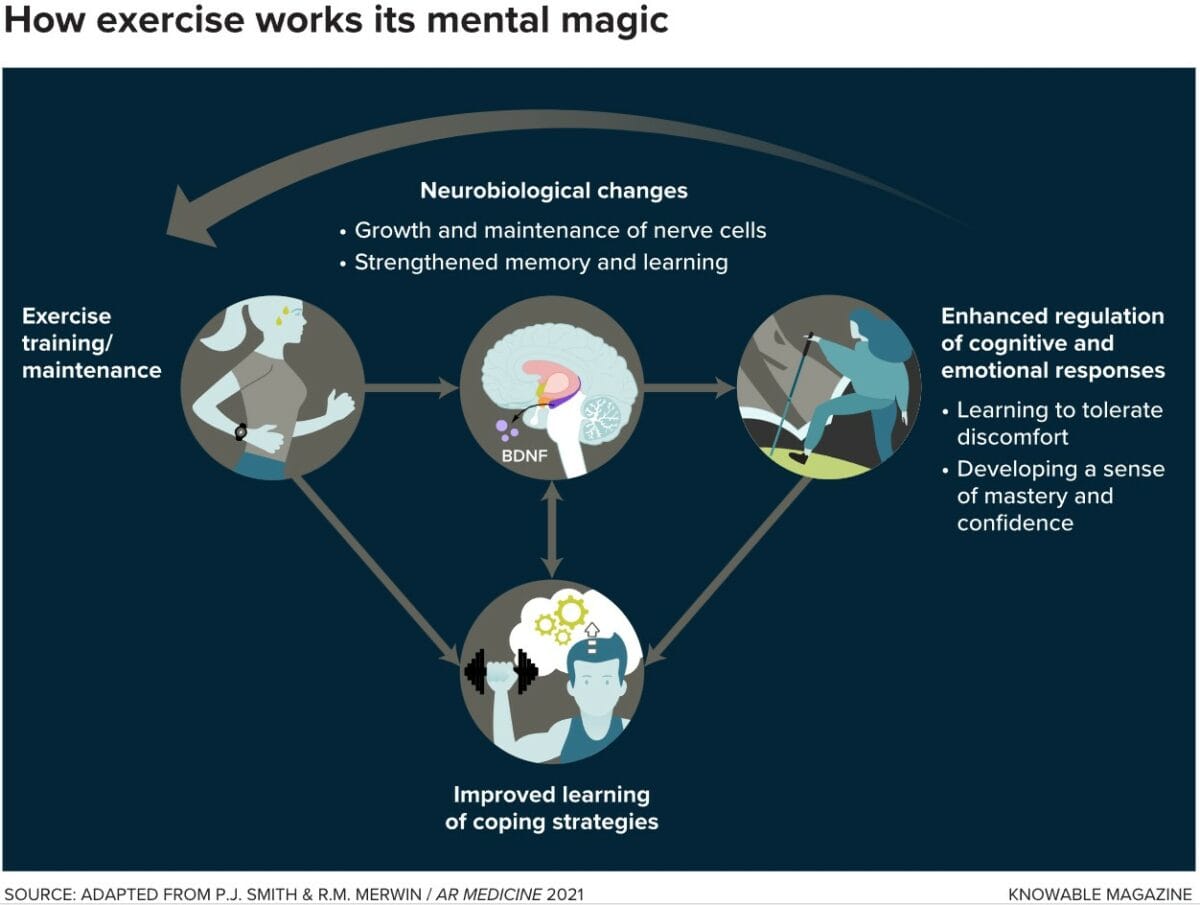
Regular exercise has numerous benefits for mental health, contributing to overall well-being and emotional balance.
Here are five key benefits:
- Reduced Stress and Anxiety: Exercise stimulates the production of endorphins, which are neurotransmitters that act as natural mood lifters. Additionally, physical activity helps lower levels of stress hormones, such as cortisol, leading to a calmer and more relaxed state of mind. Regular exercise can serve as a powerful stress management tool.
- Improved Mood and Emotional Well-being: Exercise has a positive impact on neurotransmitters like serotonin and norepinephrine, which play a crucial role in regulating mood. Engaging in physical activity can help alleviate symptoms of depression and anxiety, promoting a more positive and stable emotional state.
- Enhanced Cognitive Function: Regular exercise has been linked to improved cognitive function and a reduced risk of cognitive decline. It can enhance memory, attention, and problem-solving skills. Physical activity stimulates the release of neurotrophic factors, which support the growth and maintenance of neurons in the brain.
- Better Sleep Quality: Regular physical activity can contribute to better sleep quality. It helps regulate the sleep-wake cycle and promotes deeper, more restful sleep. Improved sleep is crucial for mental health, as it allows the brain and body to recharge and recover.
- Increased Self-Esteem and Confidence: Engaging in regular exercise can boost self-esteem and confidence. Achieving fitness goals, whether big or small, can provide a sense of accomplishment and empowerment. Physical activity also helps improve body image and self-perception, contributing to a more positive self-esteem.
What if I cannot exercise due to knee pain?
If you are prevented from exercising due to aches and pains or don’t know which exercises are good for you, get in touch with us to book an appointment with one of our practitioners who can assess you and determine the cause of the aches and pains that prevent you from exercising regularly. They can also give you a home exercise plan which can be progressed as you are able.
How do I book an appointment with a Physiotherapist near me?
Click HERE to book an appointment with a physiotherapist or chiropractor at one of our eight locations.
- Physiotherapy Etobicoke – Triangle Physiotherapy Etobicoke
- Oakville Physiotherapy Clinic – Triangle Physiotherapy Oakville
- Physiotherapy North York – Triangle Physiotherapy North York
- Mississauga Physiotherapy Clinics – Triangle Physiotherapy Mississauga
- Downtown Physiotherapy Clinics – Triangle Physiotherapy King West
- Uptown Physiotherapy Clinics – Triangle Physiotherapy Lawrence Park
- Physiotherapy Clinic Downtown Toronto – Triangle Physiotherapy Queens Quay
- Physiotherapy Clinics Mississauga – Triangle Physiotherapy Erin Mills
“Exercise offers significant benefits for your mental health, and Triangle Physiotherapy can help you integrate physical activity into your wellness routine. We provide expert physiotherapy services across the GTA, including Physiotherapy in Etobicoke, Oakville, North York, Toronto, Lawrence Park, Queens Quay, Erin Mills, Mississauga, and Liberty Village. Our team is here to support your physical and mental well-being through tailored exercise programs.”
Recovering from post-cycling tiredness is essential to optimize your performance and prevent injuries. There are some exercises and stretches to help you rejuvenate and relieve tired muscles after cycling. Before we talk about these exercises in detail let us discuss what is post cycling tiredness.
What is post cycling tiredness
Post-cycling tiredness, also known as post-ride fatigue or post-exercise fatigue, refers to the feeling of tiredness, lethargy, and muscle soreness that cyclists may experience after completing a cycling workout or ride. It is a common phenomenon that occurs as a result of the physical and physiological demands placed on the body during cycling exercise.
Several factors contribute to post-cycling tiredness:
- Muscle Fatigue: Cycling engages multiple muscle groups, including the quadriceps, hamstrings, calves, glutes, and core muscles. The repetitive pedalling motion and varying terrain can lead to muscle fatigue and soreness, especially during longer or more intense rides.
- Depletion of Energy Stores: Cycling is an endurance activity that requires sustained energy expenditure. As cyclists pedal, they utilize glycogen stores in the muscles and liver for fuel. After a ride, glycogen stores may become depleted, leading to feelings of fatigue and exhaustion.
- Fluid and Electrolyte Loss: Sweating is a natural response to exercise, and cyclists can lose significant amounts of fluid and electrolytes during rides, particularly in hot or humid conditions. Dehydration and electrolyte imbalances can contribute to feelings of fatigue and weakness post-ride.
- Muscle Damage and Inflammation: Cycling, especially over challenging terrain or at high intensities, can cause micro-tears in muscle fibres and induce inflammation in the muscles. This process, known as muscle damage, is a natural part of the muscle repair and adaptation process but can also contribute to feelings of soreness and exhaustion.
- Central Nervous System Fatigue: Prolonged or intense cycling efforts can also lead to fatigue at the central nervous system level. The brain and central nervous system play a crucial role in regulating muscle contractions, coordination, and mental focus during exercise. Fatigue at the central nervous system level can manifest as mental fatigue, decreased motivation, and impaired coordination post-ride.
Overall, post-cycling tiredness is a normal physiological response to the demands of cycling exercise. While it can be uncomfortable, it is typically temporary and can be managed with adequate rest, hydration, nutrition, and recovery strategies. Proper post-ride recovery practices and exercises including stretching, foam rolling, hydration, nutrition, and rest, can help cyclists minimize post-cycling tiredness and optimize their recovery for future rides.
Exercises and stretches to help you relieve tired muscles after cycling
Foam Rolling:
- Use a foam roller to massage tight muscles and release tension accumulated during cycling. Focus on areas such as the quadriceps, hamstrings, calves, and glutes.Roll slowly over each muscle group, pausing on any tender spots or trigger points to apply gentle pressure and encourage relaxation.
Static Stretches:
- Perform static stretches to improve flexibility and relieve muscle tightness. Hold each stretch for 20-30 seconds and repeat 2-3 times on each side.
Quadriceps Stretch:
- Stand tall and bring one heel towards your glutes, grabbing the ankle with your hand and gently pulling it towards your buttocks.
Hamstring Stretch:
- Sit on the floor with one leg extended and the other bent. Lean forward from the hips, reaching towards your toes while keeping your back straight.
Calf Stretch:
- Stand facing a wall with one foot forward and the other foot back. Lean forward, keeping the back heel on the ground, until you feel a stretch in the calf of the back leg.
Hip Flexor Stretch:
- Kneel on one knee with the other foot forward, and gently push your hips forward until you feel a stretch in the front of the hip.
Leg Elevation:
- Lie on your back with your legs extended against a wall or elevated surface. Relax your muscles and allow gravity to assist in draining fluid build-up from your legs, reducing swelling and fatigue. Elevating your legs helps improve circulation and promotes faster recovery by reducing muscle soreness and fatigue.
Low-Intensity Cardio:
- Engage in low-intensity cardiovascular activities such as walking, swimming, or gentle cycling to promote blood flow and flush out metabolic waste products from your muscles.
- Keep the intensity low to allow your body to recover without adding additional stress to fatigued muscles.
Deep Breathing and Relaxation:
- Practice deep breathing exercises and relaxation techniques to promote mental and physical relaxation. Find a quiet space, close your eyes, and focus on slow, deep breaths to reduce stress and tension in your body.
- Incorporate mindfulness or meditation practices to help calm your mind and promote overall relaxation and well-being.
Hydration and Nutrition:
- Drink plenty of water to stay hydrated and replenish fluids lost during exercise. Consume a balanced meal or snack containing carbohydrates and protein to refuel your muscles and support recovery.
Foods rich in antioxidants, such as fruits, vegetables, and nuts, can help reduce inflammation and promote recovery from exercise-induced oxidative stress.
Incorporate these exercises and recovery strategies into your post-cycling routine to help alleviate tiredness, promote muscle recovery, and restore your body’s balance and energy levels. Consider integrating Physiotherapy in Oakville as part of your recovery plan to further enhance these benefits. Listen to your body, and adjust the intensity and duration of your recovery activities based on your individual needs and preferences. Happy Cycling!
Frequently Asked Questions
- What is post-cycling tiredness?
- Post-cycling tiredness refers to the fatigue, lethargy, and muscle soreness experienced after a cycling workout, resulting from the physical and physiological demands of cycling.
- What causes post-cycling tiredness?
- Factors include muscle fatigue, depletion of energy stores, fluid and electrolyte loss, muscle damage and inflammation, and central nervous system fatigue.
- Why is foam rolling recommended after cycling?
- Foam rolling helps massage tight muscles, release tension, and improve recovery by focusing on areas like the quadriceps, hamstrings, calves, and glutes.
- How do static stretches aid in recovery?
- Static stretches improve flexibility, relieve muscle tightness, and should be held for 20-30 seconds to effectively stretch the muscle.
- What’s the proper way to perform a quadriceps stretch?
- Stand tall, bring one heel towards your glutes, grab the ankle, and gently pull it towards your buttocks.
- How does a hamstring stretch work?
- Sit with one leg extended, the other bent, and lean forward from the hips towards your toes, keeping your back straight.
- What is the benefit of calf stretches?
- Calf stretches improve flexibility in the calf muscles, essential for cyclists to relieve tightness and promote recovery.
- Why is hip flexor stretching important?
- Hip flexor stretches help alleviate tightness in the front of the hip, common in cyclists due to the cycling posture.
- How does leg elevation help in post-cycling recovery?
- Elevating legs aids in draining fluid buildup, reduces swelling and fatigue, and improves circulation for faster recovery.
- What role does hydration and nutrition play in recovery?
- Staying hydrated and consuming a balanced meal or snack post-ride replenishes fluids, refuels muscles, and supports overall recovery.
Recovering from cycling fatigue can be enhanced with the right post-cycling exercises and guidance. For personalized support, consider physiotherapy in Etobicoke, Oakville, North York, Toronto, Lawrence Park, Queens Quay, Erin Mills, Mississauga, or Liberty Village. Expert physiotherapists in these locations can provide tailored recovery plans to help you stay active and reduce tiredness effectively.
Physiotherapy can be beneficial for individuals with arthritis. Arthritis is a condition that involves inflammation and stiffness of the joints, leading to pain and reduced mobility. Physiotherapy aims to improve joint function, alleviate pain, and enhance overall quality of life through various techniques and exercises. Here are some frequently asked questions (FAQs) about physiotherapy and its role in managing arthritis:
What is arthritis or osteoarthritis?
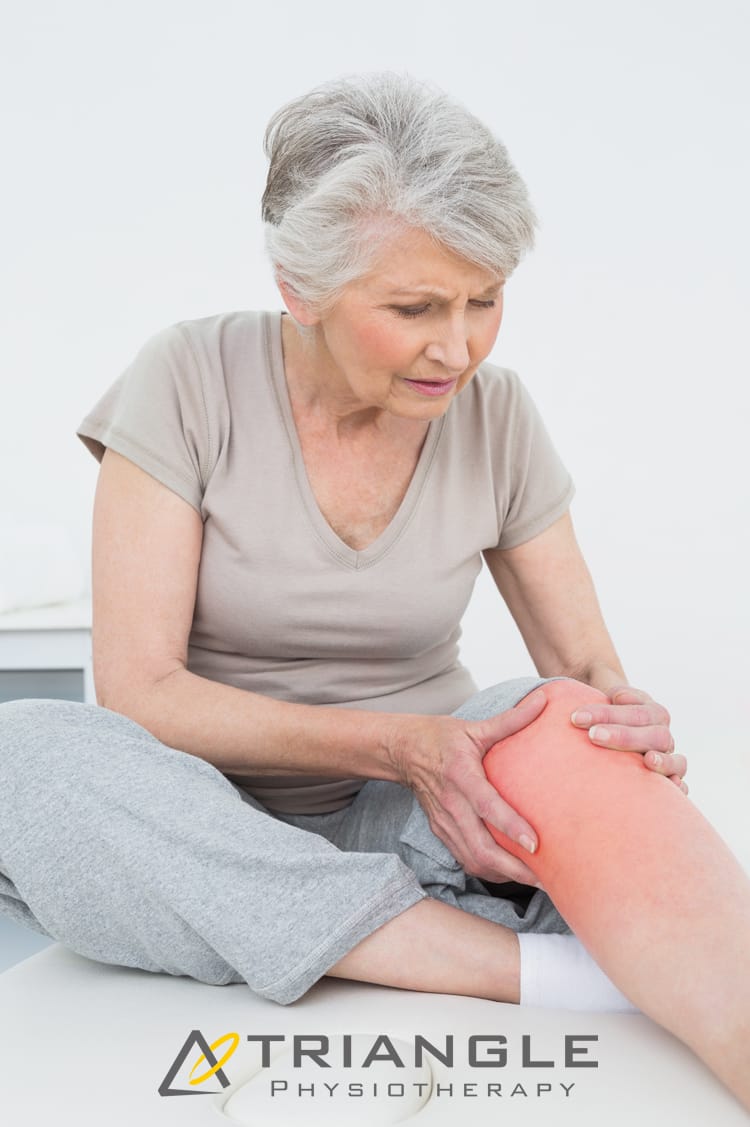
- Arthritis, also known as Osteoarthritis (OA), is one of the most common causes of a decrease in mobility and an increase in disability among older adults. It is a common condition affecting the joints, most often the knees, hips, lower back, neck, and fingers.
- In a typical joint, there is a smooth layer of cartilage over the surfaces of the bones. This cartilage has several purposes, including distributing weight evenly during movement to minimize friction and absorb any shock.
- In OA, this cartilage breaks down and causes bones to rub against each other, producing pain and, therefore, disuse of that joint. Muscle weakness due to decreased use is a commonly associated issue in osteoarthritis, which affects function and mobility in many ways.
Can physiotherapy help with the pain?
Yes, physiotherapy can help manage arthritis pain by utilizing techniques such as manual therapy, joint mobilization, and soft tissue manipulation. These techniques can help reduce pain and improve joint function.
Can physiotherapy prevent joint deformities in arthritis patients?
Early intervention through physiotherapy can help prevent or minimize joint deformities by maintaining joint function, improving muscle balance around the affected joints, and promoting proper biomechanics.
Can physiotherapy reduce the need for medication?
In some cases, successful physiotherapy can lead to reduced reliance on pain medications or other arthritis-related drugs. However, this should always be discussed with a healthcare professional.
How long does it take to see results from physiotherapy for arthritis?
The timeline for seeing results can vary based on the severity of arthritis, the individual’s response to treatment, and consistency in following the physiotherapy program. Some individuals may experience improvements within a few weeks, while others might require more time.
Is physiotherapy suitable for all types of arthritis?
Physiotherapy can be beneficial for various types of arthritis, including osteoarthritis, rheumatoid arthritis, ankylosing spondylitis, and psoriatic arthritis. However, the approach may vary depending on the specific type and individual needs.
At Physiotherapy Oakville, our experienced physiotherapists create customized treatment plans tailored to the type of arthritis you have and your unique requirements. Scientific research supports the effectiveness of physiotherapy in managing arthritis symptoms, reducing pain, and improving joint function. By joining Physiotherapy Oakville, you can take advantage of evidence-based treatments and individualized care strategies that help you manage arthritis more effectively, enhance your quality of life, and maintain your mobility and independence.
How can strength training help arthritis?
- The strength in the muscles surrounding a joint is directly related to the progression of osteoarthritis. Studies show that muscle weakness after decreased use of the joint due to pain can actually make OA progress faster, further exacerbating the disability. In normal aging, there can already be some underlying muscle wasting or weakness, making function even more difficult.
- The goals of strength training are to decrease pain, protect against worsening of the condition, and improve self-efficacy and general health/well-being. Below are some ways strength training can help OA:
- Improve joint mechanics by offloading the join with stronger muscles
- Reduce joint pain by normalizing neural firing patterns
- Decrease cartilage degeneration by decreasing inflammatory chemicals in the body that breakdown cartilage
- Decrease depression and anxiety by increasing self-efficacy, independence, and mobility
- Older adults without existing osteoarthritis can lower their chances of getting it with increased strength!
What does the evidence show?
- Pain decreased by almost 50% in as little as 2 months of strength training
- Improve walking distance by 30-45%
- Significantly decrease progression of OA in the long-term, up to 30 months after beginning strengthening exercise
What are some of the changes I can expect to see after seeing a physiotherapist?
Changes you will see!
- Easier to go up and down the stairs
- Less pain during squatting and kneeling tasks
- Ability to walk longer and faster, allowing you to enjoy outdoor activities
- Better mood and decreased emotional stress
What are some exercises to do for arthritis?
Examples of exercises
- Swimming
- great for taking the weight of your joints but challenging your muscles against the weight of the water!
- Squatting up and down from a chair
- You do this every day and it will translate directly into easier activities of daily living!
- Biking
- Another very functional, strengthening exercise that also incorporates aerobic training to increase overall health
- Single leg balance
How do I book an appointment at a Physiotherapy Clinic near me?
Click HERE to book an appointment with a physiotherapist or chiropractor at one of our eight locations.
- Physiotherapy Etobicoke – Triangle Physiotherapy Etobicoke
- Oakville Physiotherapy Clinic – Triangle Physiotherapy Oakville
- Physiotherapy North York – Triangle Physiotherapy North York
- Mississauga Physiotherapy Clinics – Triangle Physiotherapy Mississauga
- Downtown Physiotherapy Clinics – Triangle Physiotherapy King West
- Uptown Physiotherapy Clinics – Triangle Physiotherapy Lawrence Park
- Physiotherapy Clinic Downtown Toronto – Triangle Physiotherapy Queens Quay
- Physiotherapy Clinics Mississauga – Triangle Physiotherapy Erin Mills
“Physiotherapy can play a significant role in managing arthritis by improving joint function and reducing pain. Triangle Physiotherapy offers expert care across the GTA, including Physiotherapy in Etobicoke, Oakville, North York, Toronto, Lawrence Park, Queens Quay, Erin Mills, Mississauga, and Liberty Village. Our experienced physiotherapists can help you develop a personalized treatment plan to manage arthritis and enhance your quality of life.”
Warm-up exercises are essential to prepare your body for more intense physical activity by increasing blood flow to your muscles, raising your heart rate, and improving flexibility.
Here are ten effective warm-up exercises you can perform before a workout:
- Jumping Jacks: Stand with your feet together and hands by your sides. Jump and spread your feet apart while raising your arms overhead. Jump again to return to the starting position.
- High Knees: Stand with feet hip-width apart. Lift one knee at a time towards your chest while jogging on the spot, pumping your arms as you go.
- Arm Circles: Extend your arms out to the sides and make small circles with your hands, gradually increasing the size of the circles. After a few repetitions, reverse the direction.
- Leg Swings: Hold onto a stable surface (e.g., a wall or pole) for balance. Swing one leg forward and backward, and then sideways, in a controlled manner. Repeat with the other leg.
- Hip Circles: Stand with your feet hip-width apart and place your hands on your hips. Make circles with your hips, rotating in both clockwise and counterclockwise directions.
- Bodyweight Squats: Stand with feet shoulder-width apart. Lower your body into a squat position by bending your knees and pushing your hips back. Return to the starting position and repeat.
- Arm Crosses: Extend your arms straight out to the sides at shoulder height. Cross your arms in front of your chest, then open them wide again. Continue crossing back and forth.
- Butt Kicks: Stand with feet hip-width apart. Kick your heels up towards your glutes, one leg at a time, while jogging on the spot.
- Shoulder Circles: Stand with feet shoulder-width apart. Raise your shoulders up towards your ears, then roll them backward in a circular motion. Reverse the direction after a few repetitions.
- Walking Lunges: Take a step forward with one leg and lower your body into a lunge position. Push off the front foot and bring it back to the starting position. Repeat with the other leg.
FAQs
1. How long should I spend on warm-up exercises?
Aim to spend at least 5 to 10 minutes on your warm-up routine. The duration may vary depending on the intensity of your workout and personal preferences.
2. Should I stretch during the warm-up?
Dynamic stretching, which involves moving your muscles through their range of motion, is more appropriate during the warm-up. Save static stretching (holding stretches for extended periods) for after your workout.
3. Can I skip the warm-up if I’m short on time?
It’s not advisable to skip the warm-up entirely, as it increases the risk of injury and reduces your performance during the workout. If you’re short on time, shorten the warm-up but ensure you still get your heart rate up and do some dynamic movements.
4. Can I warm up without any equipment?
Absolutely! The warm-up exercises listed above require no equipment. They use your body weight and basic movements to prepare your muscles and cardiovascular system for exercise.
5. How intense should the warm-up be?
The warm-up should be less intense than the main workout. Gradually increase the intensity of the warm-up exercises to elevate your heart rate and prepare your body for the upcoming challenges.
Remember that warm-up exercises should be tailored to your specific workout routine and individual needs. A qualified physiotherapist can assess you and determine if you have any pre-existing conditions and recommend the best pre-workout routine for you.
How do I book an appointment at a Physiotherapy Clinic near me?
Click HERE to book an appointment with a physiotherapist or chiropractor at one of our eight locations.
- Physiotherapy Etobicoke – Triangle Physiotherapy Etobicoke
- Oakville Physiotherapy Clinic – Triangle Physiotherapy Oakville
- Physiotherapy North York – Triangle Physiotherapy North York
- Mississauga Physiotherapy Clinics – Triangle Physiotherapy Mississauga
- Downtown Physiotherapy Clinics – Triangle Physiotherapy King West
- Uptown Physiotherapy Clinics – Triangle Physiotherapy Lawrence Park
- Physiotherapy Clinic Downtown Toronto – Triangle Physiotherapy Queens Quay
- Physiotherapy Clinics Mississauga – Triangle Physiotherapy Erin Mills
“Performing proper warm-up exercises before a workout is essential for preventing injuries and maximizing performance. Triangle Physiotherapy offers expert guidance and care across the GTA, including Physiotherapy in Etobicoke, Oakville, North York, Toronto, Lawrence Park, Queens Quay, Erin Mills, Mississauga, and Liberty Village. Our experienced physiotherapists can help you develop a personalized warm-up routine to ensure a safe and effective workout.”

